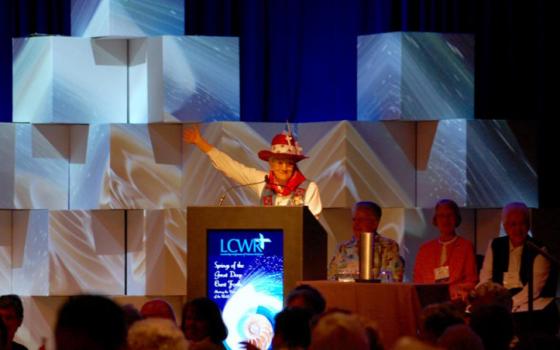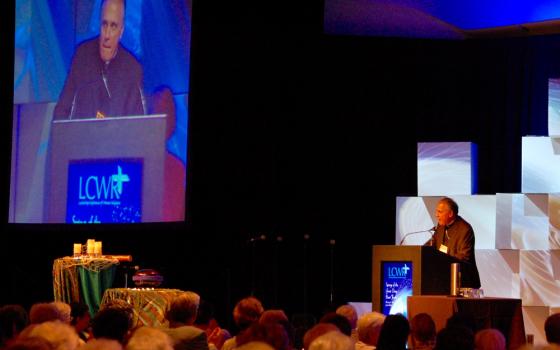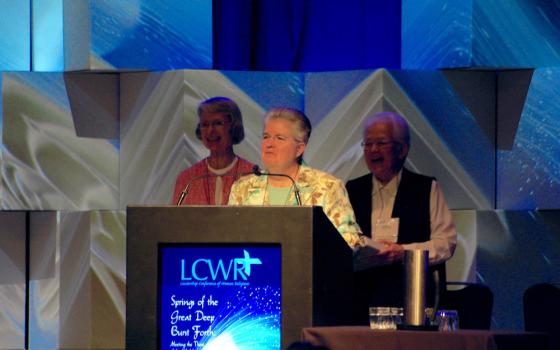The annual assembly of the nation’s largest group of Catholic women religious leaders got under way Tuesday evening, the first such gathering without the cloud of Vatican investigations in several years.
The Leadership Conference of Women Religious gathering runs through Friday evening. The organization is made up of Catholic women religious who are leaders of their orders in the United States; communities in LCWR represent about 80 percent of the nearly 50,000 women religious in the United States. Nearly 800 of the group’s 1,400 members are here for the annual conference.
For several years, women religious in the United States had been under an apostolic visitation by the Vatican, an investigation into the quality of religious life. The LCWR itself was also under a doctrinal assessment, after Vatican officials in the Congregation for the Doctrine of the Faith alleged certain LCWR presentations “undermine the revealed doctrines of the Holy Trinity, the divinity of Christ, and the inspiration of Sacred Scripture.”
But the Vatican announced its response to the apostolic visitation on Dec. 16 in a report that stressed the church’s gratitude for the work of Catholic sisters. The end of the doctrinal assessment came April 16 when LCWR leaders and church officials announced the end of three years of Vatican oversight, saying the goal of the oversight “has been accomplished.”
LCWR Past President St. Joseph Sr. Carol Zinn announced that Seattle Archbishop J. Peter Sartain will be joining the assembly Friday evening as a guest. Sartain had been appointed to oversee the Vatican-ordered reforms; there were murmurs of approval when Zinn described him as “the former bishop delegate.”
“We are delighted he accepted our invitation,” Zinn said.
There was applause when Fr. Hank Lemoncelli took the podium to read a message from Cardinal João Bráz de Aviz, who has led the Vatican's Congregation for Institutes of Consecrated Life and Societies of Apostolic Life since 2011.
“I would much rather had a sister address you tonight — a sister who works at the Institutes of Consecrated Life and speaks English,” Lemoncelli said. “If anyone of you know a sister with credentials who could work at the Vatican . . . give me her name before I leave.”
Though sisters have praised the new appreciation of women shown by the Vatican since Pope Francis was elected, they often point out that while the words are nice, there are still few, if any, women in positions of power in the church.
Lemoncelli noted that this is the third assembly he has attended and said that attending has gotten easier each time. “The first time I came [in the midst of two Vatican investigations], I was trembling,” he said. “The second time was much easier. This time I feel right at home.”
The letter from Bráz de Aviz encouraged LCWR members to “recapture the enthusiasm and joy which brought you to religious life and to wake up the world.”
Members were welcomed to Houston by Cardinal Daniel DiNardo, archbishop of Galveston-Houston, who noted the explosive growth of the diocese, but also the challenges in an area where 80 languages are spoken.
DiNardo also noted that from the very beginning of the diocese through today, it has been the work of sisters that has made many things possible.
On Thursday, members will meet with each other to discuss what they learned during the Vatican investigations; on Friday they will discuss publicly how to move forward, the first time LCWR has held an open discussion on the issue.
The assembly will close Friday evening with the presentation of the group’s Outstanding Leadership Award to LCWR’s former executive director, St. Joseph Sr. Janet Mock.
[Dan Stockman is national correspondent for Global Sisters Report. Follow him on Twitter @DanStockman and on Facebook.]



